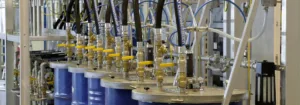A quick Google search will tell you that the global market for industrial motors used in hazardous atmospheres is set to reach well over 1 billion USD in 2023. That is roughly 1% of the total electric motor market, where buyers are typically less cost-conscious. But I digress… Let us start at the beginning.
The ATEX Directive establishes the standards for equipment and protective systems intended for use in potentially explosive atmospheres within European regulation. The directive aims to ensure the safety of workers and the environment by preventing the risk of fire or explosion caused by electrical equipment. ATEX certified electric motors are designed to eliminate or contain any potential ignition source such as arcing or excessive temperatures, and to operate safely in specific hazardous locations as classified by the directive1.
However, not all electric motors that claim to be ATEX-certified are compliant with the directive. Some manufacturers or suppliers may falsify the ATEX certification or use counterfeit labels to deceive customers and gain a competitive advantage in the market. This practice poses a serious threat to the safety and performance of the equipment and the system, as well as the users and the environment. The impact of false ATEX-certified electric motors can be devastating, as they may cause:
- Accidents and injuries: False ATEX-certified electric motors may not be able to withstand and contain an internal explosion or prevent the ignition of combustible materials in the external environment. This may result in a fire or explosion that can harm the equipment, the system, the workers, and the surroundings. For example, in 2023, a false ATEX certified electric motor caused a fire in a flour mill in Germany, injuring several workers and damaging the facility2.
- Legal consequences: False ATEX-certified electric motors may violate the ATEX directive and other relevant regulations, exposing manufacturers, suppliers, and users to legal liabilities and penalties. The authorities may impose fines, sanctions, or even criminal charges for the non-compliance or negligence of the ATEX requirements. For instance, in 2022, authorities fined a French company 500,000 euros for selling false ATEX certified electric motors to a chemical plant in Spain, leading to a major explosion that claimed two lives and injured dozens more.
- Economic losses: False ATEX-certified electric motors may compromise the quality and efficiency of the equipment and the system, leading to increased operational costs, maintenance costs, downtime, and energy consumption. Moreover, the false ATEX certification may damage the reputation and credibility of the manufacturers, suppliers, and users, affecting their market share and customer satisfaction. For example, in 2021, a British oil and gas company incurred a loss of a 10 million pounds contract after authorities discovered that they had utilized falsely certified ATEX electric motors on their offshore platform, leading to frequent breakdowns and delays.
Therefore, it is crucial to verify the authenticity and validity of the ATEX certification of electric motors before purchasing or using them in potentially explosive atmospheres. Some of the ways to check the ATEX certification are:
- Inspect the nameplate and the label: The nameplate and the label of the electric motor should clearly state the ATEX certification and the relevant information, such as the protection type, the temperature code, the equipment group and category, the gas and dust group, and the certificate number.
- Check the certificate and the documentation: Verify that a notified body, an independent organization authorized by the European Commission to assess and certify equipment compliance with the ATEX directive, issues the certificate and documentation for the electric motor. The certificate and the documentation should include the name and the address of the manufacturer, the description and the identification of the equipment, the standards and the tests applied, the results and the conclusions, and the signature and the stamp of the notified body1.
- Contact the manufacturer or the supplier: The manufacturer or the supplier of the electric motor should be able to provide the necessary information and evidence to prove the ATEX certification of the equipment. The manufacturer or the supplier should also be able to answer any questions or queries regarding the ATEX certification and the performance of the equipment. If the manufacturer or the supplier is reluctant or unable to provide the ATEX certification or the related information, it may indicate that the electric motor is not ATEX certified or is falsely certified5.
By following these steps, the users can ensure that they are buying or using genuine ATEX-certified electric motors that can operate safely and efficiently in potentially explosive atmospheres. This can help to prevent the impact of false ATEX-certified electric motors, which can be harmful to the safety, performance, and reputation of the equipment, the system, and the users.
Further Read
- ATEX Certification for Industrial Motors | Standards, Zones & Compliance
- Where ATEX Is Required | Industrial Motors ATEX Motors Guide
- The impact of counterfeit ATEX-certified electric motors on industry.
- Exploring the Origins of Ex Standards – The ATEX Directive
- Air Motors for Chemical and Pharmaceutical Industries
- Air Motors in Chemical and Pharmaceutical Applications
- What Are ATEX Areas? | Industrial Motors Guide
For further insights and detailed technical information, consult the Pocket Guide to Air Motors by Atlas Copco or Contact us directly.


